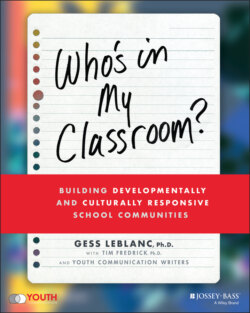Читать книгу Who's In My Classroom? - Tim Fredrick - Страница 28
References
Оглавление1 Arnett, J., Chapin, L., and Brownlow, C. (2018). Human Development: A Cultural Approach. Australia: Pearson Australia.
2 Arunkumar, R., Midgley, C., and Urdan, T. (1999). Perceiving high or low home-school dissonance: Longitudinal effects on adolescent emotional and academic well-being. Journal of Research on Adolescence 9: 441–466.
3 Bredekamp, S. and Copple, C. (1997). Developmentally Appropriate Practice in Early Childhood Programs (Revised Edition). National Association for the Education of Young Children, 1509 16th Street, NW, Washington, DC 20036-1426.
4 Bronfenbrenner, U. (1979). The Ecology of Human Development: Experiments by Nature and Design. Cambridge, MA: Harvard University Press.
5 Brown, M.R. (2007). Educating all students: Creating culturally responsive teachers, classrooms, and schools. Intervention in School and Clinic 43(1): 57–62.
6 Brown-Wright, L., Tyler, K.M., Graves, S.L., Thomas, D., Stevens-Watkins, D., and Mulder, S. (2013). Examining the associations among home–school dissonance, amotivation, and classroom disruptive behavior for urban high school students, Education and Urban Society 45(1): 142–162.
7 Cole, M. and Packer, M. (2019). Culture and cognition. Cross-cultural Psychology: Contemporary Themes and Perspectives, 243–270.
8 Comer, J. and Maholmes, J. (1999). Creating schools of child development and education in the USA: Teacher preparation for urban schools. Journal of Education for Teaching, 25: 3–5.
9 Dorado, J.S., Martinez, M., McArthur, L.E. et al. (2016). School Mental Health 8: 163. https://doi.org/10.1007/s12310-016-9177-0.
10 Elkind, D. (1967). Egocentrism in adolescence. Child Development 1025–1034.
11 Gay, G. (2000). Culturally Responsive Teaching. New York: Teachers College Press.
12 Goffin, S. (1996). Child development knowledge and early childhood teacher preparation: Assessing the relationship—A special collection. Early Childhood Research Quarterly 11: 117–133.
13 Goodman, J., Hurwitz, M., Park, J., and Smith, J. (2018). Heat and Learning. Working Paper 24639, National Bureau of Economic Research, http://www.nber.org/papers/w24639.
14 Greenfield, P.M., Keller, H., Fuligni, A., and Maynard, A. (2003). Cultural pathways through universal development. Annual Review of Psychology 54: 461–90.
15 Haberman, M. (1988). Proposals for recruiting minority Martin Haberman teachers: Promising practices and attractive detours. Journal of Teacher Education 39(4): 38–44.
16 Hammond, Z. (2014). Culturally Responsive Teaching and the Brain: Promoting Authentic Engagement and Rigor Among Culturally and Linguistically Diverse Students. Thousand Oaks, CA: Corwin Press.
17 Heisner, M.J. and Lederberg, A.R. (2011). The impact of child development associate training on the beliefs and practices of preschool teachers. Early Childhood Research Quarterly, 2nd Quarter, 26(2): 227–236.
18 Hollins, E.R. and Spencer, K. (1990). Restructuring schools for cultural inclusion: Changing the schooling process for African American youngsters. Journal of Education 172(2): 89–100.
19 Howard, T. (2010). Why Race and Culture Matter in Schools: Closing the Achievement Gap in America's Classrooms. New York: Teachers College Press.
20 Keller, H. (2017). Culture and development: A systematic relationship. Perspectives on Psychological Science 12(5): 833–840.
21 Kumar, R. (2006). Students’ experiences of home–school dissonance: The role of school academic culture and perceptions of classroom goal structures. Contemporary Educational Psychology 31: 253–279.
22 Ladson-Billings, G. (1994). The Dreamkeepers: Successful Teachers of African American Students. San Francisco: Jossey-Bass.
23 Mayford, M., Siegelbaum, S.A., and Kandel, E.R. (2012). Synapses and memory storage. Cold Spring Harbor Perspectives in Biology 4(6): a005751.
24 Muñiz, J. (2019). Culturally Responsive Teaching: A 50-State Survey of Teaching Standards. newamerica.org/education-policy/reports/culturally-responsive-teaching/.
25 NCATE (2010). The Road Less Traveled: How the Developmental Sciences Can Prepare Educators to Improve Student Achievement: Policy Recommendations. National Council for Accreditation of Teacher Education, Inc.
26 National Institute of Child Health and Human Development, NIH, DHHS. (2007). Child and adolescent development research and teacher education: Evidence-based pedagogy, policy, and practice. Washington, DC: U.S. Government Printing Office.
27 New York State Education Department (2019). Culturally Responsive and Sustaining Framework, NYSED, p. 11.
28 Nielsen, M., Haun, D., Kärtner, J., and Legare, C.H. (2017). The persistent sampling bias in developmental psychology: A call to action. Journal of Experimental Child Psychology 162: 31–38.
29 Nieto, S. (ed.). (2005). Why We Teach. New York: Teachers College Press.
30 Rogoff, B. (1990). Apprenticeship in Thinking: Cognitive Development in Social Context. New York: Oxford.
31 Slaughter-Defoe, D.T., Nakagawa, K., Takanishi, R., and Johnson, D.J. (1990). Toward cultural/ecological perspectives on schooling and achievement in African-and Asian-American children. Child Development 61(2): 363–383.
32 Tharp, R. and Gallimore, R. (1988). Rousing Minds to Life: Teaching, Learning, and Schooling in Social Context. New York: Cambridge University Press.
33 Tudge, J.R.H. (2008). The Everyday Lives of Young Children: Culture, Class, and Child Rearing in Diverse Societies. New York: Cambridge University Press.
34 Venables, D.R. (2011) The Practice of Authentic PLCs: A Guide to Effective Teacher Teams. Thousand Oaks, CA: Corwin Press.
35 Warren, C.A. (2018). Empathy, teacher dispositions, and preparation for culturally responsive pedagogy. Journal of Teacher Education 69(2): 169–183.
36 Wilson, S., Floden, R.E., and Ferrini-Mundy, J. (2002). Teacher preparation research: An insider's view from the outside. Journal of Teacher Education 53(3): 190–204.
